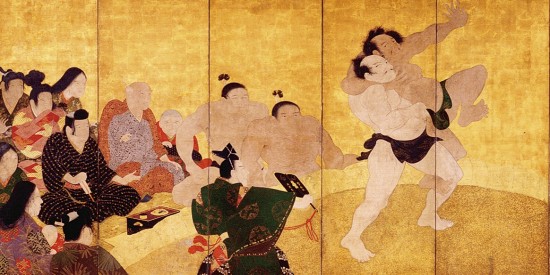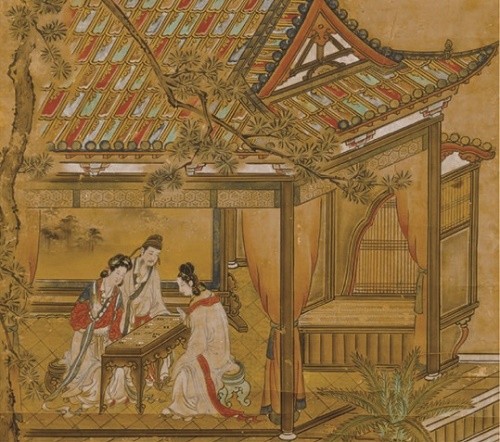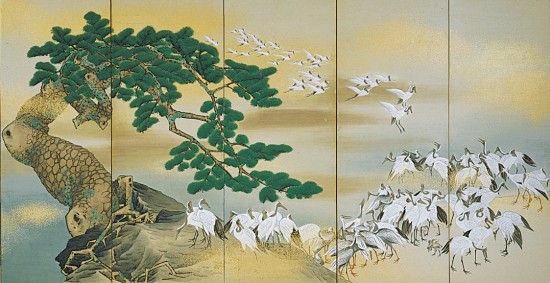Good Fortune / Great Beauty
Part I: September 17 (Saturday) – November 9 (Wednesday), 2016
Part II: November 11 (Friday), 2016 – January 9 (Monday, national holiday), 2017
Kankai Pavilion (Traditional East Asian Art)
Since ancient times in Japan, auspicious motifs have been used for special occasions, seasonal holidays and in daily life as wishes for good fortune. “Fortune” is the theme of this season’s exhibition, along with “Beauty,” as variously depicted in pictures of scenery, flora and fauna and people.

Sumo match (detail), pair of six-fold screens, Edo period [Part I]
The featured works include representations of Yang Guifei, Xi Shi and Wang Zhaojun, three of the so-called “Four Great Beauties” of China, and motifs such as pine, bamboo, plum, crane, tortoise and the rising sun that are used as symbols of longevity, fertility and wealth.

Princess Yanquifei playing chess, Kano Sotoku, Edo period

A hundred cranes (detail), Mori Tetsuzan, pair of six-fold screens, Edp period [Part II]
[Featured Works]
Traditional Art: [Part I & II] Landscape of Yodo River, Maruyama Okyo, hand scroll, Edo period /Pair of Satsuma ware sake bottles with their portable case, maki-e on lacquer, Edo period / Ruyi (Buddhist ritual implement) engraved with figures, jade, Qing dynasty, 19th century and others
[Part I] Rei Shojo, with flower basket, attributed to Jasoku, Muromachi period / Princess Yanquifei playing chess, Kano Sotoku, Edo period / King Wu at the palace, Kano Sa’yemon, Edo period and others
[Part II] Landscape of Mt. Fuji, Shiba Ko’kan, Edo period / A hundred cranes, Mori Tetsuzan, Edo period / Sumo match, Edo period / Seaside landscape with sunrise, Yokoyama Taikan, Meiji period and others
Contemporary Art: Toshinobu Onosato, Galaxy, 1979 / Noe Aoki, Tateyama, 2007 and others
[Related Events]
1.Workshop: Make Your Own Dream Catcher
October 8 (Saturday) 1:00 – 3:00 pm, Instructor: Noka166
2. Artist Talk: An Autumn Evening with Tabaimo: From the Solo Exhibition Yumechigae to Now
November 19 (Saturday) 5:00 – 7:00 pm Speaker: Tabaimo
Hara Museum ARC
Address: 2855-1 Kanai, Shibukawa-shi, Gunma 377-0027
Tel 0279-24-6585 Fax 0279-24-0449 E-mail arc@haramuseum.or.jp
http://www.haramuseum.or.jp (official website) http://mobile.haramuseum.or.jp (mobile site) https://www.art-it.asia/en/u/HaraMuseum_e (blog) http://twitter.com/HaraMuseumARC (Twitter)
Hours: 9:30 am – 4:30 pm (last entry at 4:00 pm)
Closed: Thursdays (except when a national holiday) and January 1 *Subject to temporary closure in the event of severe weather.
Admission: General 1,100 yen, Students 700 yen (high school and university) or 500 yen (elementary and junior high), Free for Hara Museum members, 10% discount for a group of 20 or more, Combination ticket for Hara Museum ARC and Ikaho Green Bokujo (except during Golden Week): General 1,800 yen; Students 1,500 yen (high school and university) or 1,400 yen (junior high), 800 yen (elementary), half price for those over 70, discount for groups of 20 or more
*Children must be accompanied by an adult.
*For residents of Gunma Prefecture: Free admission for elementary and junior high school children every Saturday during the school term/200-yen-discount on admission for up to five persons upon presentation of the Guchoki Passport. October 28, Friday is Gunma Prefectural Citizen’s Day. Admission on this day will be free for college students residing in the prefecture. An original gift will also be presented to the first 50 visitors from the general public.
Directions: By train: Take the Joetsu Shinkansen to Takasaki, change to the Joestu Line, and disembark at Shibukawa. From Shibukawa, ARC is 10 minutes away by taxi or 15 minutes by bus (take the Ikaho Onsen bus to ″Green Bokujo Mae″). By car: 8 kilometers (about 15 minutes) from the Kan-etsu Expressway Shibukawa Ikaho Interchange (in the direction of Ikaho Onsen).
